
Peter, Heloisa and Auke cruising Westwards around the globe with s/v Mundinho
Our position is updated regularly. Click on Current Position (right side) to find out where we are.
18 December 2012 | Shelter Bay Panama
28 November 2012
19 August 2012 | Panama city BYC
14 August 2012 | 7 34.734'N:78 11.947'W, Bahia Pina, Panama
04 August 2012 | 1 48.992'N:78 43.717'W, Tumaco - Colombia
29 July 2012 | 8 24.0264'N:79 04.9178'W, Isla Pedro Gonzalez - Archipel Las Perlas
23 July 2012 | Panama city
21 July 2012 | Colon, Panama
17 July 2012 | Colon, Panama
10 July 2012 | 9 35.228'N:78 52.950'W, Chichime
29 June 2012 | 9 35.346'N:78 40.542'W, Kalugir Tupu and Banedup
26 June 2012 | 9 35.191'N:78 44.751'W, Miriadiadup
24 June 2012 | 9 35.231'N:78 52.839'W, Uchutupu Pippi
21 June 2012 | 9 32.722'N:78 53.754'W, Cay Limon
15 June 2012 | Colon Panama
13 June 2012 | Shelter BAy, Colon Panama
11 June 2012
08 June 2012
06 June 2012 | Shelter Bay, Colon Panama
04 June 2012 | Shelter Bay, Colon Panama
Our days in the Kuna Yala
17 July 2012 | Colon, Panama
Peter via Internet
We are on our way back from the San Blas to Christobal the entrance of the Panama Canal, near Colon while I write this. The weather is calm, with low SE winds in the aft quarter and slight raining. We have spent 4 weeks in the San Blas, or Kuna Yala as the official name is by the Indian language (Chibcha) of the Kuna's.

The Kuna's is the indian tribe which live in the San Blas and basically owns it. The Kuna tribes were granted almost autonomous rule in the region of San Blas in 1938. The initial creation of an autonomous area inside Panama was due to a violent uprising in 1925 of the Kunas against violent inroads by outsiders. In the uprising the Kunas killed many Panamanian officials, like policeman and even children of mixed blood living in the islands. Only foreign intervention (mainly US, which were present in Panama due to the Panama Canal) prevented the Panamanian government from executing a bloody retribution.
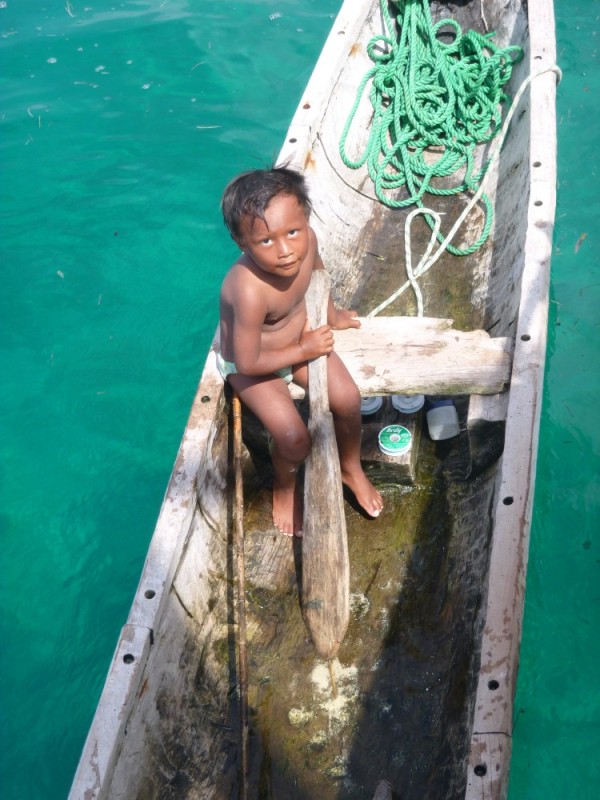
Nowadays it is estimated that around 55.000 Kunas are around and still live the way their forefathers lived (to some extent). There traditional lifestyle is based on their law that the land and sea belongs to all Kunas. This Kuna law, common amongst other tribes around the world and a common law amongst hunter-gatherer tribes has prevented so far divisions of the Kunas in "haves" and "have nots". It also ensured that the typical Kuna is very proud of the area he lives in as the area is recognized truly as their area, their grounds.
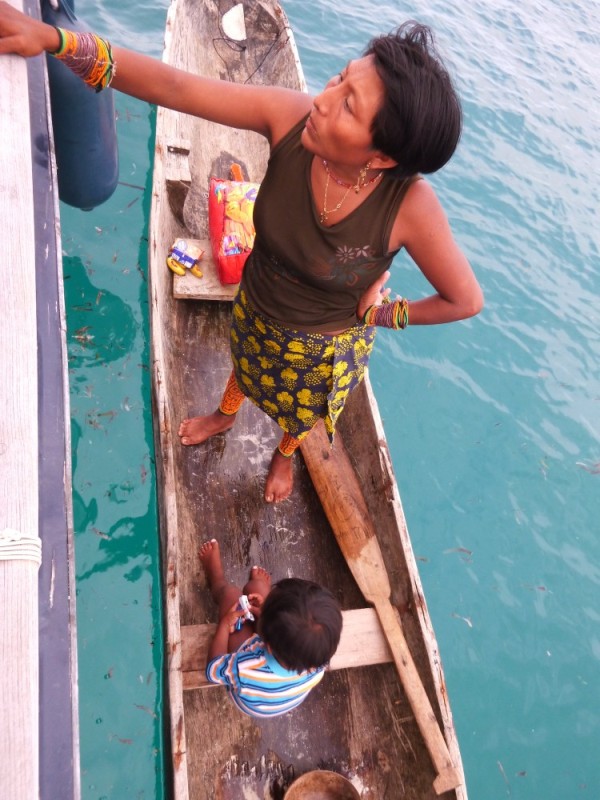
However naturally with the increasing contact with foreigners on sailing boats, and well to do Panamanians on sport fish boats, also here you see the first "cracks in the wall" of traditional culture appearing. A good example is the following story that was told to me by the foreigner involved by a project, installing moorings. This foreigner (cruiser) had "the great idea" to suggest to some Kunas living on some islands surrounding a great fully protected anchorage to install moorings and rent the moorings out to cruisers. Since the foreigner was a diver, he would install them. The Kuna family living on the largest islands surrounding the ideal protected anchorage must have liked the idea as it went ahead and in no time over 30 moorings in 20 meters water depth had been installed in the anchorage, leaving barely room for normal anchoring. So basically the Kuna family had claimed the anchorage for themselves so it appeared. After a year the foreigner moved away from that "project" for personal reasons, while remaining in the San Blas area. When I met him, I asked him who managed the moorings now since he had moved on. I had noticed that each mooring was in use when we had anchored nearby there. The foreigner suspected no one, and indeed we had not seen anyone checking on the moorings and / or collecting fees. Due to the Kuna laws and way of living, their culture, there is no ownership, there cannot be ownership of that patch of water. So no one is likely to collect the mooring fees (as that would indicated that particular Kuna family claiming ownership), and no one is maintaining the moorings. Each cruiser knows that moorings not being maintained are likely to fail after just a few years in a marine environment, if not earlier. So an in our western mindset great idea of making money from the cruisers appeared to have completely failed under the Kunas to produce anything due to their centuries old way of living. I have seen it before in my travels that we Westerns always feel we need to present a way of making monies to less developed cultures, thereby ignoring their culture, or simply thinking that their culture will quickly let go of old "cultural laws" and adept new ones. Eventually also the Kunas will adopt new rules and will eventually adept to more western methods of money making I am sure as history has proven over and over again. However that will take time, much more time then we Westerners often can imagine or are comfortable with.

Kunas travel by boat, all canoes dug out from a single tree trunk, and are called Ulus. You see them everywhere and handled (rowed) by male or female or kids alike. They all have a small bench in the back and just forward of the middle and a small square elevated portion that can hold a mast with sail.
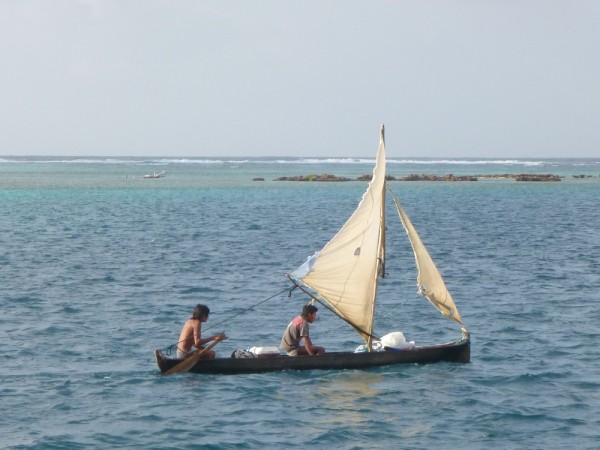
The mast is nothing more than a stick and the sail is nothing more than some ragged pieces of cloth woven together. Since the Kunas live on small to very small islands, everything happens with canoes. Fishing, interacting with other families, transporting goods, selling molas, lobster and fish to cruisers etc.
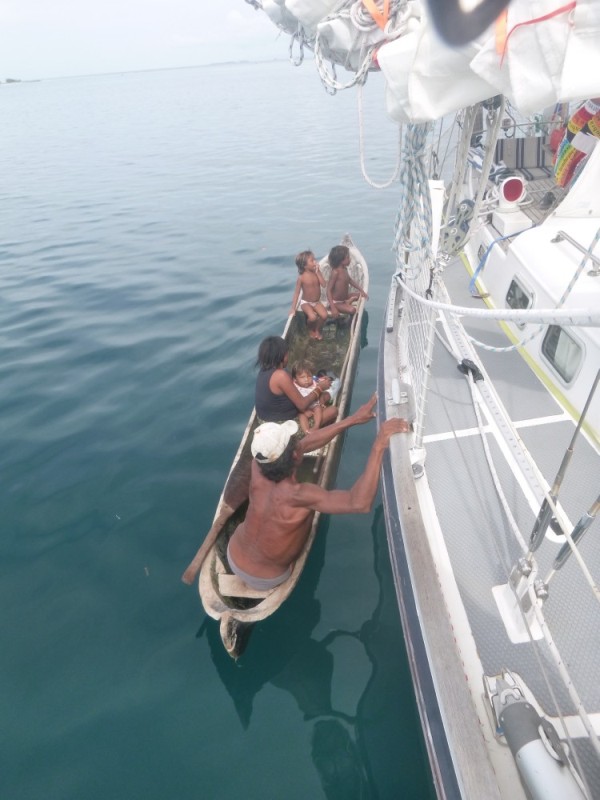
It is very obvious to see that due to handling their canoes daily the Kunas are immensely strong and with great stamina. Regularly I asked passing by Kunas in their canoes, rowing or sailing, where they were heading to, to which they often would point to some island in the far, far distance. A distance I would not even think of to row over in a dugout tree trunk that is called a canoe.
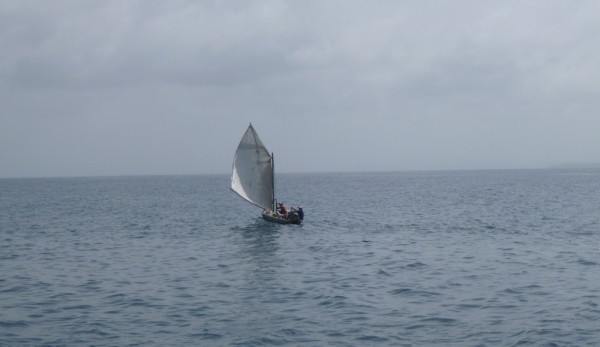
Remember that although the San Blas is well sheltered, a fair chop is regularly present due to fair winds and the infamous Caribbean swell is often very much present, especially when you cross one of the three major openings between the islands. Nothing to even get uncomfortable with on a cruising boat, however in a floating tree trunk with 25cm freeboard, that is really something else.

That it sometimes does go wrong can only be obvious. We made a deal with a Kuna, he would get us some decent size lobster three days from that day. We did not want them today and he had none, so this give him some days to catch them. After day two he came back, he told us that in a blow the sea had flippep their canoes, with everyone in it (three Kunas) and they had lost all their snorkel gear. Their snorkel gear typically consist of an old mask and sometimes snorkel given by some cruisers in the past. Naturally catching lobster without mask is not possible. We had one spare with snorkel which we gave him. The next day as agreed he returned with a nice bag of lobsters.

That is how they make some money, selling lobster, fish or their famous Molas. This is the handcraft from the Kunas and very nice made. You see them everywhere and they go from small and cheap to large and beyond our financial capability to pay. Kunas also have nice crafted wooden figures. With the money they buy goods in the villages, or perhaps a fishing hooks and line.
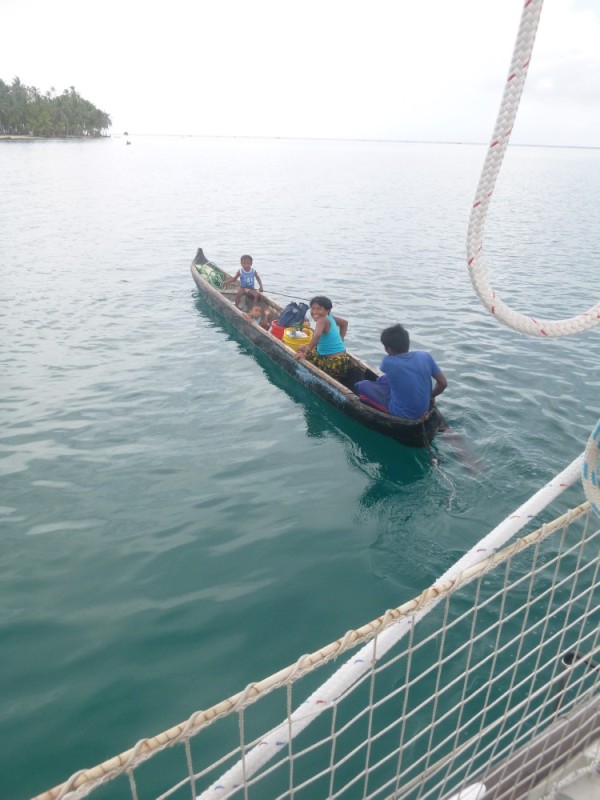
There is also another source of income, something I had seen before on earlier travels down the coast of Central America. It is called the "lotteria de mar" (lottery of the sea). If you win de lotteria it means you have found one or more of the block of cocaine that floats around in the Caribbean and end up downwind on the shores of the islands or mainland. These cocaine blocks the size of two typical house bricks taped together have been dumped in the sea by drugs running boats (Open skiffs with 4 large outboard engines on the back, large drums of fuel inside, propelling them at the speed of light over the water, stuffed with cocaine blocks in everyspace they have left on board, or old converted fishing boats, which I had a rather uncomfortable experience with in 1995 while travelling over sea from Panama to Columbia while backpacking our way down South with a good friend) on their way from Columbia to more northern locations, when being charged or boarded by drug chasers, like to Columbian, Panamanian and US government. The drug cartels by back the blocks from any finder for 2.000 USD a piece. That is a good deal for both the cartels and the Kunas. I know, I do not want to get into the discussion whether cocaine is good or not, the fact is it is there and the cocaine blocks will continue to float onto the beaches of the islands. I met one Kuna who I showed him my respect for him being able to sail his Ulu across the seas. He told me in Spanish "not for long". Why? I asked him, to which he proudly told me he was about to buy a decent size outboard engine which he was going to stick to the back of his Ulu. Wondering where he possible could earn all the money for an outboard engine (you would need to sell an lot of lobsters, fish and molas in order to have enough monies for a decent size outboard engine), he saw my surprise and confusion and told me about the "lotteria de mar".
The friendliness of the Kunas is extremely present. Of all our travels we have seldom found tribes so inherently friendly. When they try to sell you some molas or fish or lobster and you say politely "no", they still happily smile and not push on to sell you something. They come by to ask for water, and hand you an old gallon bottle to fill up. That is a change from places like Jamaica or even Cuba where they would ask for beer or liquor and would get cross often if you would not just hand them some.
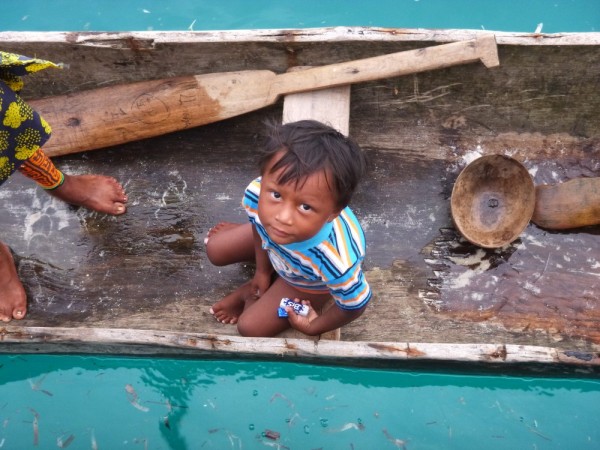
Modern technology enters the Kuna lifestyle as well, often brought back by Kunas who have left the San Blas for working in cities like Panama City. Do not be surprised to find a Kuna rowing a dugout canoe and having a working cellular phone somewhere in his pockets. He will come to the cruising boats to ask if you can charge his cellphone, as most islands (virtually all) have no electricity, none at all. After the sun goes down around 18:00, you will see a wood fire where the meals are being cooked for another hour. After that it is dark on the islands, pitch dark. Here and there you see a flashlight at times, where some Kuna is trying to find its way to the next hut.
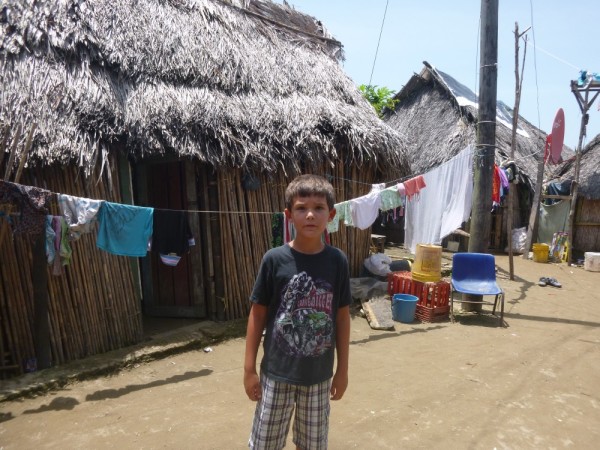
Kunas live in huts made of reed or cane for the sides and some palm fronds make up the roof. They cook often outside in a secondary smaller hut. Although the huts appear to be in a continuous state of collapse, we have seen them withstanding 35 knots winds gusting to 50 knots, (except for one, which blew apart and was built back up three days later...).
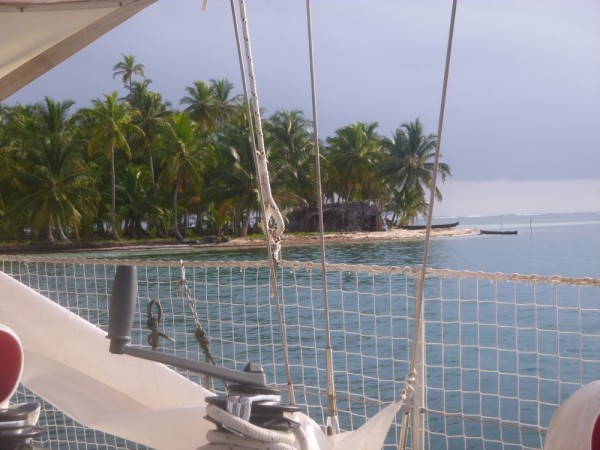
Most islands have two or three families in several huts living on them. A few islands are the centers of the San Blas for the Kunas and have so many huts, they pile out over the sides, literally. The huts are surounded by coconut trees, the coconut which hitorically has always provided the main source of income for the Kunas. Coconuts were often bought by Colombian traders. Each tree is owned by some Kuna and before you cut yourself some you should alwasy ask the owner.
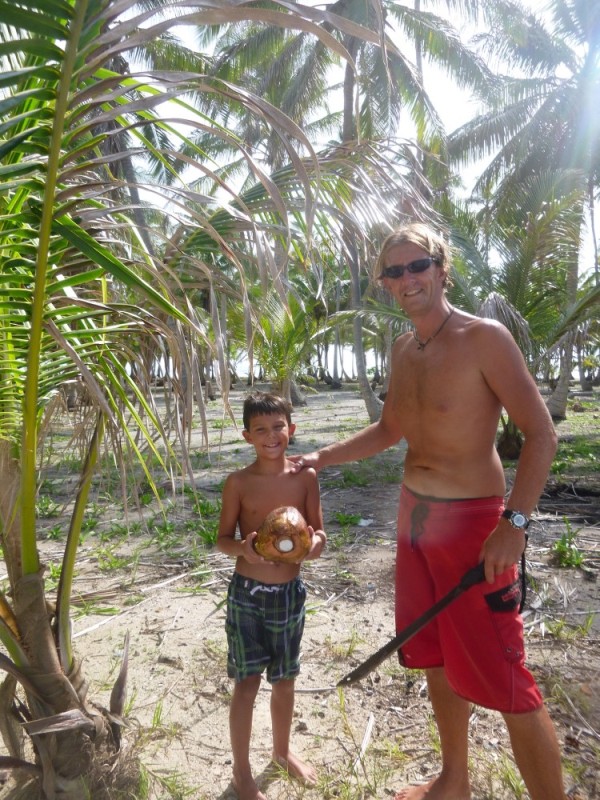
After week three in the San Blas we were so ready for some fresh eggs and vegetables that we headed 16 Nm NE to the Carti Islands, still within the San Blas group of islands. There reportedly were some shops with "fresh" produce, Carti Island was a large village they said. Well indeed huts were pouring over the sides upon arrival.
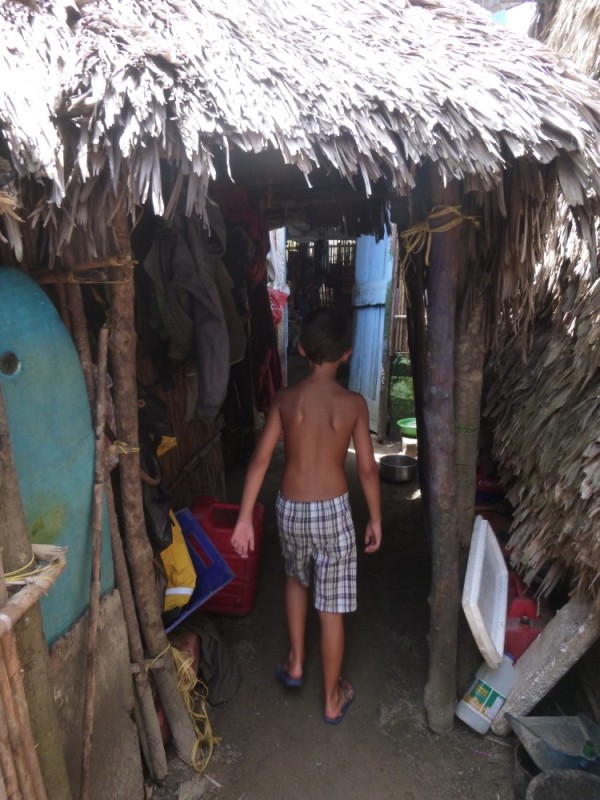
With not even the anchor on the bottom a Kuna approached us in his ulu, (dugout canoe), "do you want to buy things? Yes I said, eggs and vegetables and fresh bread, you have that? Si, claro!! (yes, sure he said). I asked him; so there is a tienda (shop)?. No he replied from his canoe, followed by; there is a supermarcado!! (supermarket). Wow both Heloisa and myself said, this is going to be good, we thought. Load her up with eggs and veggies and bread. I even thought by myself, so much of the primitive lifestyle of the Indians, they have a supermarket!

The huts on the island are so closely built together, which makes the alleyways so narrow that you have to walk sideways if you meet someone there. There is not a real landing for a dinghy. There are plenty private landings, but then you step inside the living room of one of the huts. Juan who had told us about the supermercado told us he would bring us to the supermercado and waited for us on his dinghy dock.
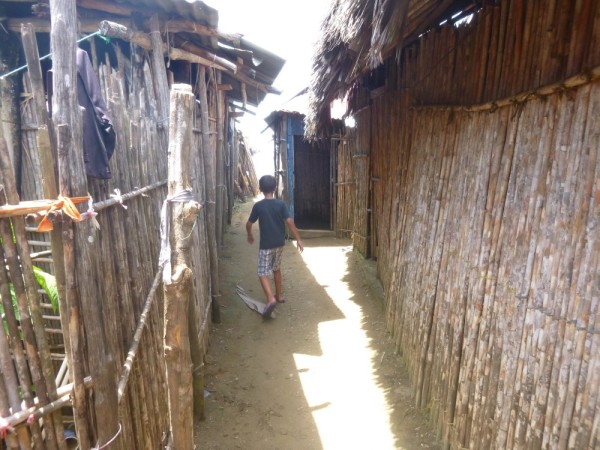
Well things were not exactly as they had been presented... The supermercado was the half side of a hut not in use, with shelves of canned food. Not just any canned food, the worse of the canned food. There was no light as there is no electricity. There were at least 8 beautiful Kunas ladies "working" while there were no clients. Furthermore plenty crates with bottled sodas. The veggie corner was three wooden crates, two of which were empty and on the bottom of the third were a few tiny (but tasteful) bell peppers. On another wooden shelf Heloisa found tomatoes and onions, yeah! There were nine eggs available and Heloisa took them all. For fresh bread we had to go to the bakery, which was just a hut where someone had just baked fresh bread. It could have been any of the other huts. The bread is the best however.
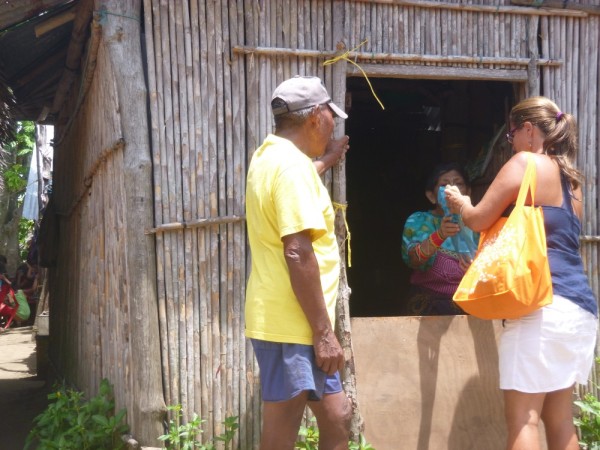
All in all a very interesting experience where again the friendliness of the Kunas was exceptional. On many of the tight built islands you are not supposed to wander alone and on some you first have to ask permission of the chief in the congresso. The congresso is simply a (very) large hut which houses the chief and the local parliament if things needs to be discussed. You can go there in the afternoon to meet the chief to ask permission to land. You cannot go in the morning, as then they are typically fishing or tending to their coconut trees, also the chief.
We often bought lobster from the Kunas. Sometimes big ones, but the midsize taste better. Also the big ones are nice on your plate according Heloisa, but not too nice while still alive in your hand.

Any lobster Heloisa turned into great feasts each time. We have tried ourselves to find lobster, however we were never really successful, we only would find the tiny ones.
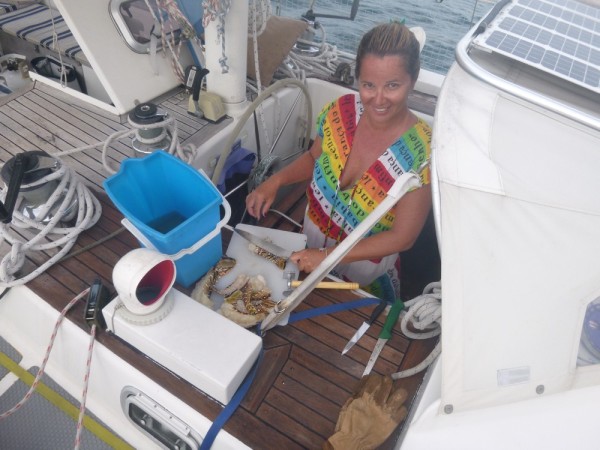
I had more success with spearfishing, which has become a great sport for me. It is often the midsize panfish you run into, jacks and snappers, but once and a while a large jack or barracuda presents itself in front of your spear, which really triggers my killing instinct. Unfortunately it does not trigger my fish cleaning instinct, so I leave that up to Heloisa.
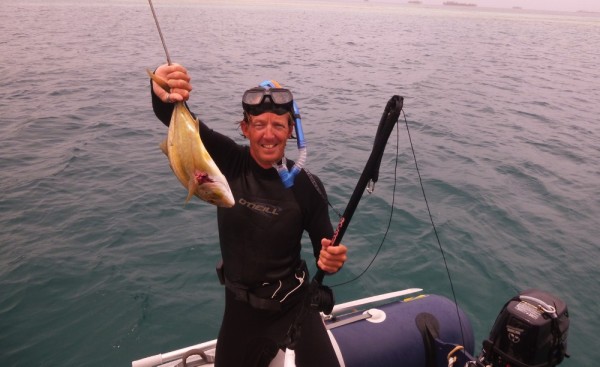
Moving in between the islands we often caught fish on the lines, heavy duty lines with 150KG break strength, heavy duty connection etc. as I was fed up losing lines to big catches. We typically troll two lines with different lures. The last catch was a large king mackerel which Heloisa turned into a nice moqueca, a Brazilian fish stew. Man, you gotta love that woman who can cook such food.
The weather overall was not too good. The first week after our arrival in the San Blas was fine, with occasional rain showers typical for the time of the year.

However then it started, rain most of the days and in between the rain drizzle, squalls, some of them heavy with strong winds.
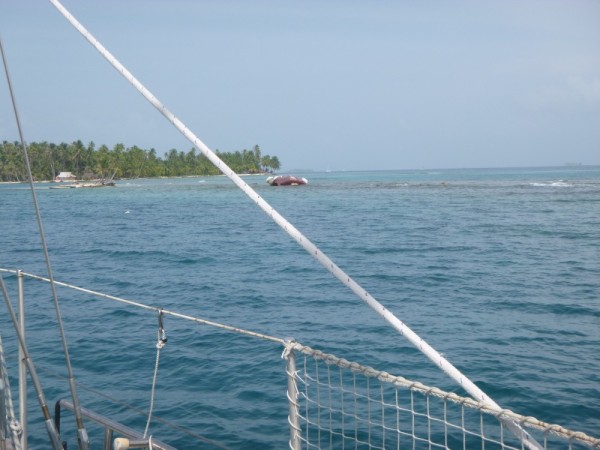
We are always cautious with anchorages as we want to have the room to swing and put out enough heavy chain scope to deal with the unexpected. However after days of calm weather we were lured into tight anchorages with other boats, surrounded with reefs everywhere. It went well, however after we run into one squall which had 35 knots continuous for half an hour and gusting to 50 knots, we only selected the best anchorages which allowed us to swing 360 degrees and pay out enough heavy chain. I always say, anchor chain is not worth anything if it stays on board in the locker. It must be in the water.
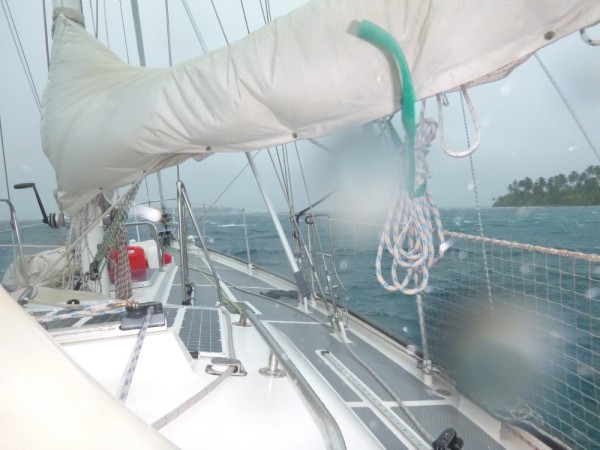
Once you have been hit by a typically full blown squall while surrounded by razor sharp reefs, squalls where winds pick up in just a few seconds to 35 knots and 50 knots gusts which will push your vessel over to one side you quickly realize the usefulness of lots of heavy chain behind a very heavy anchor. We had several of these squall in just one week, which caused at least 4 boats in the San Blas to end up on reefs or sandbars, of which 2 boats were still there high and dry when we left the San Blas. One boat which was anchored right next to us moved backwards so fast during a squall that I was sure he had lost his anchor (I could only see him on the radar, due to the rainfall). They came to rest against a sandbar quarter mile back and easily were able to get back into their original position once the winds came down. Their anchor was just fine, all attached, it simply had not done what it was supposed to do, hold the boat in position. Once you saw the anchor you knew why, it was simply not large enough. Here you had a full blown cruising boat, heavy displacement, full keel and a Mickey Mouse chunk of welded plates together at the front what was supposed to be an anchor. We see it all the time.
Our days were filled with school for Auke in the morning (if there is one thing we all three do not care about is it the home schooling.

Heloisa and I do not like the teaching and Auke thinks school is unnecessary, a common thought amongst seven year olds and actually nowadays a common thought under many teenagers I believe). While Auke is on school with Heloisa, I would often go out to shoot some fish for the evening dinner. After school it is swimming time for Auke who nowadays easily goes down to 5 meters depth holding his breath, and then even sticks around to pick up things from the sea bottom to study and only then slowly ascends back to surface.
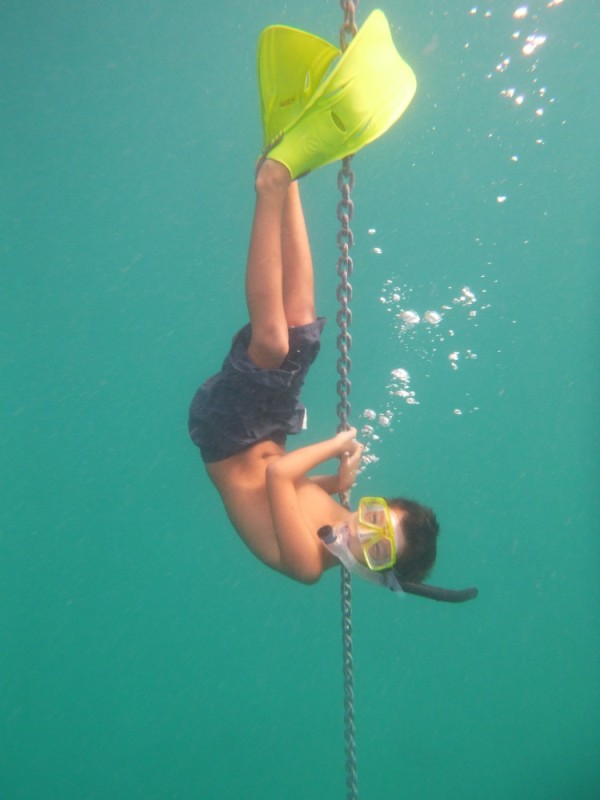
In the afternoon the three of us would go snorkeling or Auke would play monkey on the swing we had prepared from the spinnaker boom over the side.
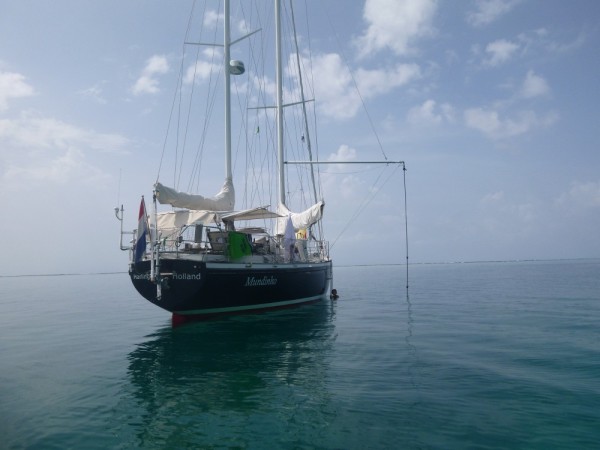
By the end of the afternoon Heloisa and myself would get ready for sundowner(s), planting Auke behind a DVD (so easy nowadays to get kids quite) after we all had a great shower with water we produced our self in our new watermaker. (Did you know that showers are better with homemade water). Life is truly good on those days and moments.
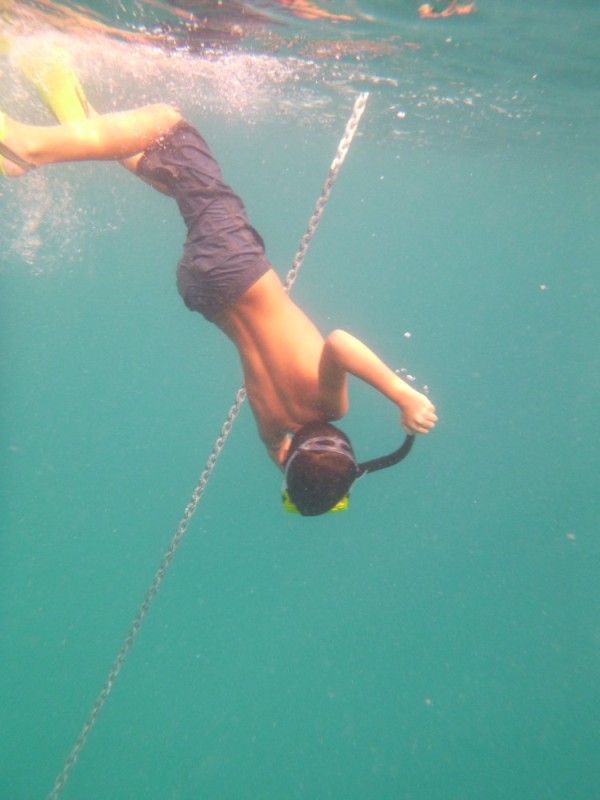
In the final days of our San Blas stay we helped another cruiser back on its way. This cruiser had run onto a reef the days before during the heavy squall, subsequently had been pulled off by the Kunas in the 24 hours afterwards, sailed to the next anchorage and while anchoring next us, got his dinghy painter in his propeller, causing his engine to shut down. I offered to jump in and untangle the mess, which they greatly appreciated. However with the line removed, me already back on Mundinho, things were still not good. The cruisers wife came over in their dinghy, "our boat is filling up in water was her comment". Well that is not good, not good for any boat really and she, while standing in her dinghy obviously would not let go of our railing till someone had fixed that pouring in of water. Heloisa asked her to come on board Mundinho and I went over and offered my help. It turned out the dinghy painter line had pulled the entire propshaft back 20cm (7 inches), straight out of the coupling. This had placed the shaft key way in the shaft gland, which as most cruisers know cannot seal around a keyway. So water was pouring in via the keyway. We got it temporally fixed so they could at least sleep for the night without the cruisers wife having fear for going down with the boat while asleep. We fixed it together the next day by pushing the shaft back in and bolting everything up. His wife, all new to cruising had just come on board one week ago, had in that one week experienced one severe grounding in a bad squall, followed by the pounding of 14 Kunas over their deck for one full day of their 40ft boat while the Kunas tried to free their boat from the reef and now the pulled-out propeller shaft causing the loss of power and pouring in of water inside the boat. That is not a good start to convince your wife to join you on your cruising adventure, I really had to do with the poor fellow. His lovely wife seemed now more further away than ever to join him in fullfilling his cruising dreams. They both got us a nice barbeque going on a tiny island the next day, which made all the effort all worth it. Auke and myself are so happy with our Heloisa, which has embraced the cruising lifestyle. (Possible due to the fact that we did not loose prop shafts yet, nor have we been grounded yet).
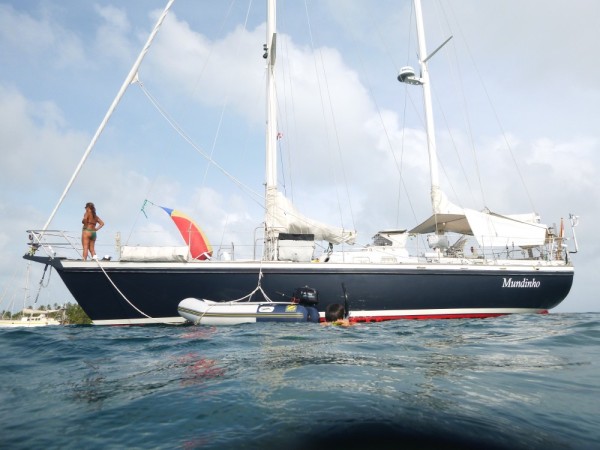
On Mundinho so far everything worked as it should be. They only thing we need in the not too far distance is new antifouling. It is growing faster around the waterline then we can clean. That is something for Ecuador perhaps, or Tahiti, not sure. First I need to find the antifouling paint, suitable for aluminum. The disadvantage of aluminum, you are bound to some very specific paints etc, not always readily available. Saturday July the 21st we cross the Panama Canal and after about two days on the Panama city anchorage we will head for Ecuador, about a 550Nm trip. From there on to the Galapagos and onward to French Polynesia.
We will keep you posted on the canal crossing, which for someone from Holland is not too exciting. However there are plenty of horror stories around with boats floating backwards or upside down in and out of the Panama locks, after line handlers did not hold on to the lines, so we will be alert and keep on our toes to make that a happy ending.
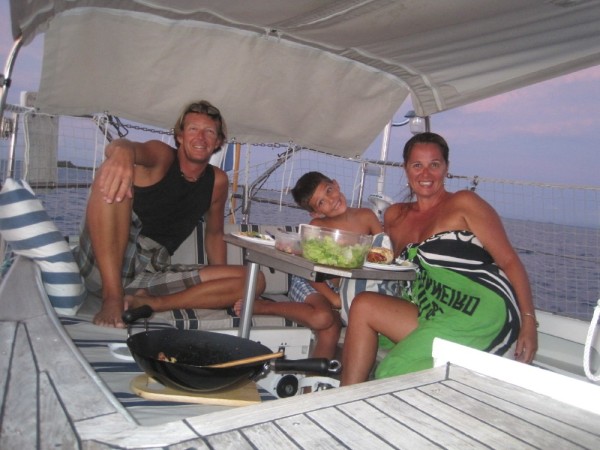
All well with boat and crew.

The Kuna's is the indian tribe which live in the San Blas and basically owns it. The Kuna tribes were granted almost autonomous rule in the region of San Blas in 1938. The initial creation of an autonomous area inside Panama was due to a violent uprising in 1925 of the Kunas against violent inroads by outsiders. In the uprising the Kunas killed many Panamanian officials, like policeman and even children of mixed blood living in the islands. Only foreign intervention (mainly US, which were present in Panama due to the Panama Canal) prevented the Panamanian government from executing a bloody retribution.

Nowadays it is estimated that around 55.000 Kunas are around and still live the way their forefathers lived (to some extent). There traditional lifestyle is based on their law that the land and sea belongs to all Kunas. This Kuna law, common amongst other tribes around the world and a common law amongst hunter-gatherer tribes has prevented so far divisions of the Kunas in "haves" and "have nots". It also ensured that the typical Kuna is very proud of the area he lives in as the area is recognized truly as their area, their grounds.

However naturally with the increasing contact with foreigners on sailing boats, and well to do Panamanians on sport fish boats, also here you see the first "cracks in the wall" of traditional culture appearing. A good example is the following story that was told to me by the foreigner involved by a project, installing moorings. This foreigner (cruiser) had "the great idea" to suggest to some Kunas living on some islands surrounding a great fully protected anchorage to install moorings and rent the moorings out to cruisers. Since the foreigner was a diver, he would install them. The Kuna family living on the largest islands surrounding the ideal protected anchorage must have liked the idea as it went ahead and in no time over 30 moorings in 20 meters water depth had been installed in the anchorage, leaving barely room for normal anchoring. So basically the Kuna family had claimed the anchorage for themselves so it appeared. After a year the foreigner moved away from that "project" for personal reasons, while remaining in the San Blas area. When I met him, I asked him who managed the moorings now since he had moved on. I had noticed that each mooring was in use when we had anchored nearby there. The foreigner suspected no one, and indeed we had not seen anyone checking on the moorings and / or collecting fees. Due to the Kuna laws and way of living, their culture, there is no ownership, there cannot be ownership of that patch of water. So no one is likely to collect the mooring fees (as that would indicated that particular Kuna family claiming ownership), and no one is maintaining the moorings. Each cruiser knows that moorings not being maintained are likely to fail after just a few years in a marine environment, if not earlier. So an in our western mindset great idea of making money from the cruisers appeared to have completely failed under the Kunas to produce anything due to their centuries old way of living. I have seen it before in my travels that we Westerns always feel we need to present a way of making monies to less developed cultures, thereby ignoring their culture, or simply thinking that their culture will quickly let go of old "cultural laws" and adept new ones. Eventually also the Kunas will adopt new rules and will eventually adept to more western methods of money making I am sure as history has proven over and over again. However that will take time, much more time then we Westerners often can imagine or are comfortable with.

Kunas travel by boat, all canoes dug out from a single tree trunk, and are called Ulus. You see them everywhere and handled (rowed) by male or female or kids alike. They all have a small bench in the back and just forward of the middle and a small square elevated portion that can hold a mast with sail.

The mast is nothing more than a stick and the sail is nothing more than some ragged pieces of cloth woven together. Since the Kunas live on small to very small islands, everything happens with canoes. Fishing, interacting with other families, transporting goods, selling molas, lobster and fish to cruisers etc.

It is very obvious to see that due to handling their canoes daily the Kunas are immensely strong and with great stamina. Regularly I asked passing by Kunas in their canoes, rowing or sailing, where they were heading to, to which they often would point to some island in the far, far distance. A distance I would not even think of to row over in a dugout tree trunk that is called a canoe.

Remember that although the San Blas is well sheltered, a fair chop is regularly present due to fair winds and the infamous Caribbean swell is often very much present, especially when you cross one of the three major openings between the islands. Nothing to even get uncomfortable with on a cruising boat, however in a floating tree trunk with 25cm freeboard, that is really something else.

That it sometimes does go wrong can only be obvious. We made a deal with a Kuna, he would get us some decent size lobster three days from that day. We did not want them today and he had none, so this give him some days to catch them. After day two he came back, he told us that in a blow the sea had flippep their canoes, with everyone in it (three Kunas) and they had lost all their snorkel gear. Their snorkel gear typically consist of an old mask and sometimes snorkel given by some cruisers in the past. Naturally catching lobster without mask is not possible. We had one spare with snorkel which we gave him. The next day as agreed he returned with a nice bag of lobsters.

That is how they make some money, selling lobster, fish or their famous Molas. This is the handcraft from the Kunas and very nice made. You see them everywhere and they go from small and cheap to large and beyond our financial capability to pay. Kunas also have nice crafted wooden figures. With the money they buy goods in the villages, or perhaps a fishing hooks and line.

There is also another source of income, something I had seen before on earlier travels down the coast of Central America. It is called the "lotteria de mar" (lottery of the sea). If you win de lotteria it means you have found one or more of the block of cocaine that floats around in the Caribbean and end up downwind on the shores of the islands or mainland. These cocaine blocks the size of two typical house bricks taped together have been dumped in the sea by drugs running boats (Open skiffs with 4 large outboard engines on the back, large drums of fuel inside, propelling them at the speed of light over the water, stuffed with cocaine blocks in everyspace they have left on board, or old converted fishing boats, which I had a rather uncomfortable experience with in 1995 while travelling over sea from Panama to Columbia while backpacking our way down South with a good friend) on their way from Columbia to more northern locations, when being charged or boarded by drug chasers, like to Columbian, Panamanian and US government. The drug cartels by back the blocks from any finder for 2.000 USD a piece. That is a good deal for both the cartels and the Kunas. I know, I do not want to get into the discussion whether cocaine is good or not, the fact is it is there and the cocaine blocks will continue to float onto the beaches of the islands. I met one Kuna who I showed him my respect for him being able to sail his Ulu across the seas. He told me in Spanish "not for long". Why? I asked him, to which he proudly told me he was about to buy a decent size outboard engine which he was going to stick to the back of his Ulu. Wondering where he possible could earn all the money for an outboard engine (you would need to sell an lot of lobsters, fish and molas in order to have enough monies for a decent size outboard engine), he saw my surprise and confusion and told me about the "lotteria de mar".
The friendliness of the Kunas is extremely present. Of all our travels we have seldom found tribes so inherently friendly. When they try to sell you some molas or fish or lobster and you say politely "no", they still happily smile and not push on to sell you something. They come by to ask for water, and hand you an old gallon bottle to fill up. That is a change from places like Jamaica or even Cuba where they would ask for beer or liquor and would get cross often if you would not just hand them some.

Modern technology enters the Kuna lifestyle as well, often brought back by Kunas who have left the San Blas for working in cities like Panama City. Do not be surprised to find a Kuna rowing a dugout canoe and having a working cellular phone somewhere in his pockets. He will come to the cruising boats to ask if you can charge his cellphone, as most islands (virtually all) have no electricity, none at all. After the sun goes down around 18:00, you will see a wood fire where the meals are being cooked for another hour. After that it is dark on the islands, pitch dark. Here and there you see a flashlight at times, where some Kuna is trying to find its way to the next hut.

Kunas live in huts made of reed or cane for the sides and some palm fronds make up the roof. They cook often outside in a secondary smaller hut. Although the huts appear to be in a continuous state of collapse, we have seen them withstanding 35 knots winds gusting to 50 knots, (except for one, which blew apart and was built back up three days later...).

Most islands have two or three families in several huts living on them. A few islands are the centers of the San Blas for the Kunas and have so many huts, they pile out over the sides, literally. The huts are surounded by coconut trees, the coconut which hitorically has always provided the main source of income for the Kunas. Coconuts were often bought by Colombian traders. Each tree is owned by some Kuna and before you cut yourself some you should alwasy ask the owner.

After week three in the San Blas we were so ready for some fresh eggs and vegetables that we headed 16 Nm NE to the Carti Islands, still within the San Blas group of islands. There reportedly were some shops with "fresh" produce, Carti Island was a large village they said. Well indeed huts were pouring over the sides upon arrival.

With not even the anchor on the bottom a Kuna approached us in his ulu, (dugout canoe), "do you want to buy things? Yes I said, eggs and vegetables and fresh bread, you have that? Si, claro!! (yes, sure he said). I asked him; so there is a tienda (shop)?. No he replied from his canoe, followed by; there is a supermarcado!! (supermarket). Wow both Heloisa and myself said, this is going to be good, we thought. Load her up with eggs and veggies and bread. I even thought by myself, so much of the primitive lifestyle of the Indians, they have a supermarket!

The huts on the island are so closely built together, which makes the alleyways so narrow that you have to walk sideways if you meet someone there. There is not a real landing for a dinghy. There are plenty private landings, but then you step inside the living room of one of the huts. Juan who had told us about the supermercado told us he would bring us to the supermercado and waited for us on his dinghy dock.

Well things were not exactly as they had been presented... The supermercado was the half side of a hut not in use, with shelves of canned food. Not just any canned food, the worse of the canned food. There was no light as there is no electricity. There were at least 8 beautiful Kunas ladies "working" while there were no clients. Furthermore plenty crates with bottled sodas. The veggie corner was three wooden crates, two of which were empty and on the bottom of the third were a few tiny (but tasteful) bell peppers. On another wooden shelf Heloisa found tomatoes and onions, yeah! There were nine eggs available and Heloisa took them all. For fresh bread we had to go to the bakery, which was just a hut where someone had just baked fresh bread. It could have been any of the other huts. The bread is the best however.

All in all a very interesting experience where again the friendliness of the Kunas was exceptional. On many of the tight built islands you are not supposed to wander alone and on some you first have to ask permission of the chief in the congresso. The congresso is simply a (very) large hut which houses the chief and the local parliament if things needs to be discussed. You can go there in the afternoon to meet the chief to ask permission to land. You cannot go in the morning, as then they are typically fishing or tending to their coconut trees, also the chief.
We often bought lobster from the Kunas. Sometimes big ones, but the midsize taste better. Also the big ones are nice on your plate according Heloisa, but not too nice while still alive in your hand.

Any lobster Heloisa turned into great feasts each time. We have tried ourselves to find lobster, however we were never really successful, we only would find the tiny ones.

I had more success with spearfishing, which has become a great sport for me. It is often the midsize panfish you run into, jacks and snappers, but once and a while a large jack or barracuda presents itself in front of your spear, which really triggers my killing instinct. Unfortunately it does not trigger my fish cleaning instinct, so I leave that up to Heloisa.

Moving in between the islands we often caught fish on the lines, heavy duty lines with 150KG break strength, heavy duty connection etc. as I was fed up losing lines to big catches. We typically troll two lines with different lures. The last catch was a large king mackerel which Heloisa turned into a nice moqueca, a Brazilian fish stew. Man, you gotta love that woman who can cook such food.
The weather overall was not too good. The first week after our arrival in the San Blas was fine, with occasional rain showers typical for the time of the year.

However then it started, rain most of the days and in between the rain drizzle, squalls, some of them heavy with strong winds.

We are always cautious with anchorages as we want to have the room to swing and put out enough heavy chain scope to deal with the unexpected. However after days of calm weather we were lured into tight anchorages with other boats, surrounded with reefs everywhere. It went well, however after we run into one squall which had 35 knots continuous for half an hour and gusting to 50 knots, we only selected the best anchorages which allowed us to swing 360 degrees and pay out enough heavy chain. I always say, anchor chain is not worth anything if it stays on board in the locker. It must be in the water.

Once you have been hit by a typically full blown squall while surrounded by razor sharp reefs, squalls where winds pick up in just a few seconds to 35 knots and 50 knots gusts which will push your vessel over to one side you quickly realize the usefulness of lots of heavy chain behind a very heavy anchor. We had several of these squall in just one week, which caused at least 4 boats in the San Blas to end up on reefs or sandbars, of which 2 boats were still there high and dry when we left the San Blas. One boat which was anchored right next to us moved backwards so fast during a squall that I was sure he had lost his anchor (I could only see him on the radar, due to the rainfall). They came to rest against a sandbar quarter mile back and easily were able to get back into their original position once the winds came down. Their anchor was just fine, all attached, it simply had not done what it was supposed to do, hold the boat in position. Once you saw the anchor you knew why, it was simply not large enough. Here you had a full blown cruising boat, heavy displacement, full keel and a Mickey Mouse chunk of welded plates together at the front what was supposed to be an anchor. We see it all the time.
Our days were filled with school for Auke in the morning (if there is one thing we all three do not care about is it the home schooling.

Heloisa and I do not like the teaching and Auke thinks school is unnecessary, a common thought amongst seven year olds and actually nowadays a common thought under many teenagers I believe). While Auke is on school with Heloisa, I would often go out to shoot some fish for the evening dinner. After school it is swimming time for Auke who nowadays easily goes down to 5 meters depth holding his breath, and then even sticks around to pick up things from the sea bottom to study and only then slowly ascends back to surface.

In the afternoon the three of us would go snorkeling or Auke would play monkey on the swing we had prepared from the spinnaker boom over the side.

By the end of the afternoon Heloisa and myself would get ready for sundowner(s), planting Auke behind a DVD (so easy nowadays to get kids quite) after we all had a great shower with water we produced our self in our new watermaker. (Did you know that showers are better with homemade water). Life is truly good on those days and moments.

In the final days of our San Blas stay we helped another cruiser back on its way. This cruiser had run onto a reef the days before during the heavy squall, subsequently had been pulled off by the Kunas in the 24 hours afterwards, sailed to the next anchorage and while anchoring next us, got his dinghy painter in his propeller, causing his engine to shut down. I offered to jump in and untangle the mess, which they greatly appreciated. However with the line removed, me already back on Mundinho, things were still not good. The cruisers wife came over in their dinghy, "our boat is filling up in water was her comment". Well that is not good, not good for any boat really and she, while standing in her dinghy obviously would not let go of our railing till someone had fixed that pouring in of water. Heloisa asked her to come on board Mundinho and I went over and offered my help. It turned out the dinghy painter line had pulled the entire propshaft back 20cm (7 inches), straight out of the coupling. This had placed the shaft key way in the shaft gland, which as most cruisers know cannot seal around a keyway. So water was pouring in via the keyway. We got it temporally fixed so they could at least sleep for the night without the cruisers wife having fear for going down with the boat while asleep. We fixed it together the next day by pushing the shaft back in and bolting everything up. His wife, all new to cruising had just come on board one week ago, had in that one week experienced one severe grounding in a bad squall, followed by the pounding of 14 Kunas over their deck for one full day of their 40ft boat while the Kunas tried to free their boat from the reef and now the pulled-out propeller shaft causing the loss of power and pouring in of water inside the boat. That is not a good start to convince your wife to join you on your cruising adventure, I really had to do with the poor fellow. His lovely wife seemed now more further away than ever to join him in fullfilling his cruising dreams. They both got us a nice barbeque going on a tiny island the next day, which made all the effort all worth it. Auke and myself are so happy with our Heloisa, which has embraced the cruising lifestyle. (Possible due to the fact that we did not loose prop shafts yet, nor have we been grounded yet).

On Mundinho so far everything worked as it should be. They only thing we need in the not too far distance is new antifouling. It is growing faster around the waterline then we can clean. That is something for Ecuador perhaps, or Tahiti, not sure. First I need to find the antifouling paint, suitable for aluminum. The disadvantage of aluminum, you are bound to some very specific paints etc, not always readily available. Saturday July the 21st we cross the Panama Canal and after about two days on the Panama city anchorage we will head for Ecuador, about a 550Nm trip. From there on to the Galapagos and onward to French Polynesia.
We will keep you posted on the canal crossing, which for someone from Holland is not too exciting. However there are plenty of horror stories around with boats floating backwards or upside down in and out of the Panama locks, after line handlers did not hold on to the lines, so we will be alert and keep on our toes to make that a happy ending.

All well with boat and crew.
Comments
| Vessel Name: | Mundinho |
| Vessel Make/Model: | Koopmans 42 - Ketch - Alu Centerboard |
| Hailing Port: | Harlingen - Holland |
| Crew: | Peter, Heloisa and Auke |
| About: | We are a family of three, a rather international get together with myself being Dutch, my lovely wife being Brazilian and our 7 year old son who carries a Dutch and Brazilian citizenship |
| Extra: | You can follow us here during our two year sailing trip that will take us together via the Caribbean and the Islands in the Pacific to New Zealand. Beyond that I will take Mundinho to Europe solo. |
| Home Page: | www.sv-mundinho.com |
Gallery not available
Family of three travelling West Bound (slowly)
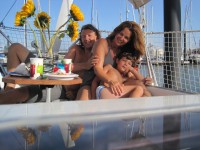
Who: Peter, Heloisa and Auke
Port: Harlingen - Holland
All Blogs posted
Peter and Heloisa and their 7 year old son Auke are traveling with their sailing vessel a Koopmans 42. On this blog you can find updates regularly posted of their preparation and trip itself. Feel free to leave a message or raise a question if you have any for Peter and Heloisa.